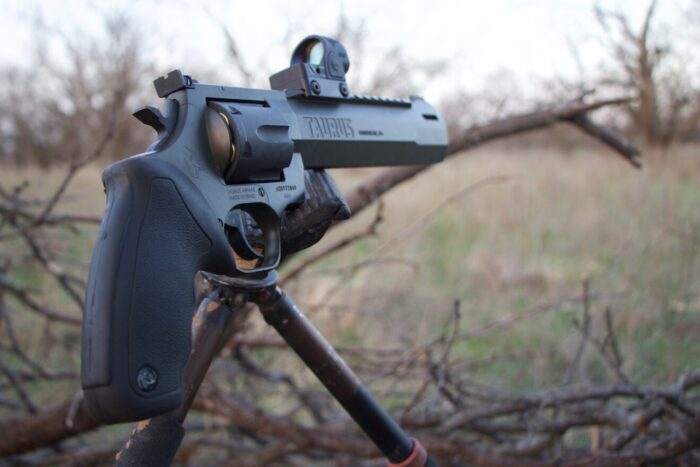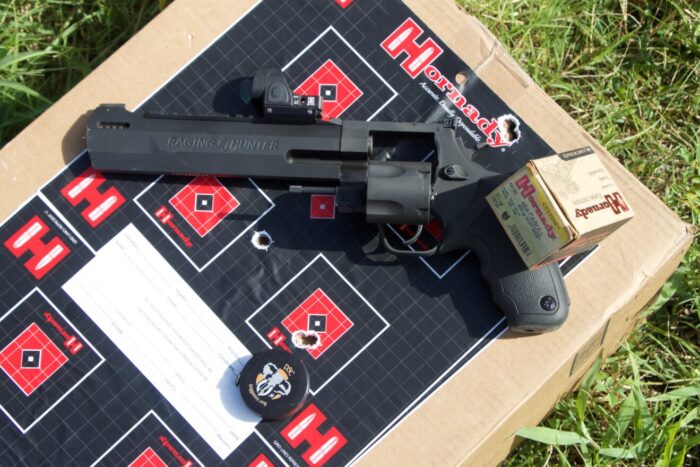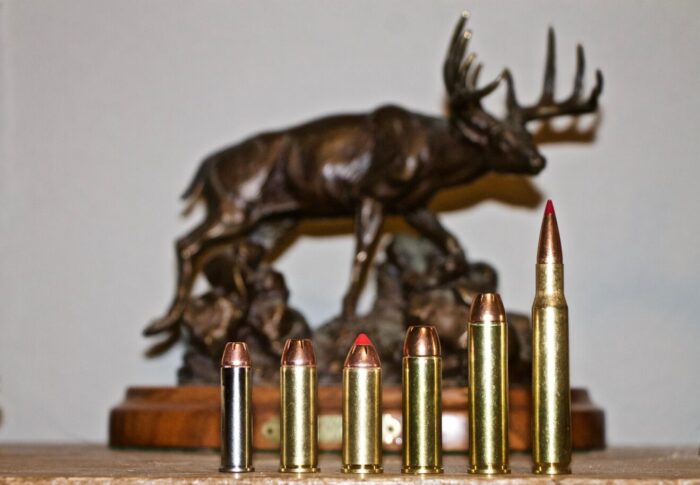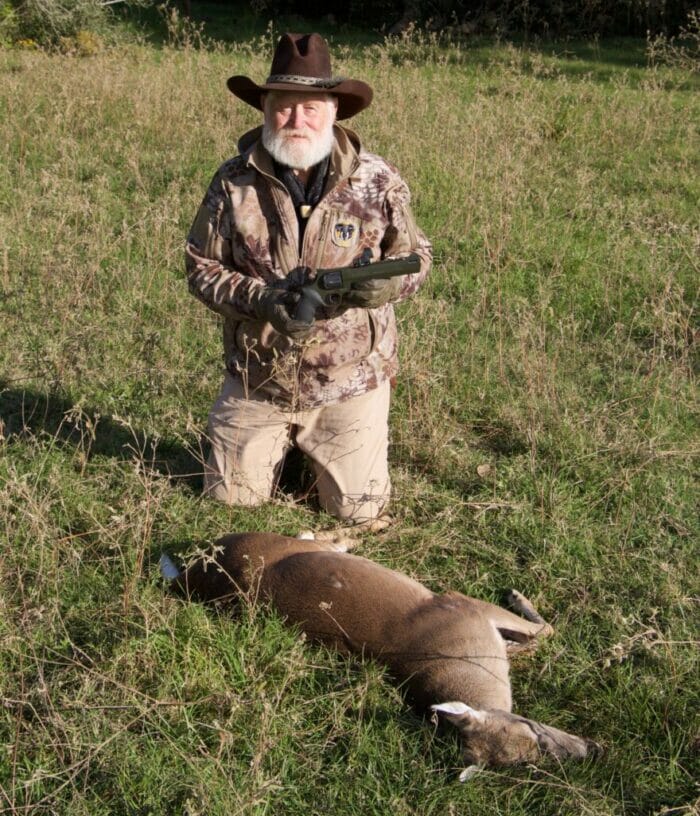Hunting 101: How to Select the Right Handgun for Hunting
“What do you suggest for a first-time hunting handgun; caliber, round, style, sights, ammo?” I was asked by someone in the back of the room where I was doing a talk at a DSC gathering.
I love someone asking about the possibility of a new or additional hunting challenge. My first statement is always the same, “Hunting with a handgun is not unlike shooting a rifle; the bullet goes where the barrel is pointed when the trigger is pulled!”. The perception of hunting with a short barrel being extremely challenging is not quite a reality. After choosing the right equipment and ammo, following a few simple “take a rest” techniques and some practice, almost anyone can shoot accurately to take most medium-sized animals; wild hogs, whitetail, and possibly mule deer and black bear, wherever handguns are considered “legal firearms.”
Choosing the right handgun and caliber for you!
Up front, I am not keen on semi-autos as hunting handguns. They are excellent for personal defense or simply shooting a lot of rounds fast, merely my opinion. To me, there are three, possibly four types of hunting handguns; bolt action, break-open single-shot, single-action revolver, and double-action revolver.
Bolt action handguns like the Remington XP and Savage Striker are no longer produced.
Break-open single-shots, primarily those produced by Thompson/Center in the Contender or Encore, are available in a wide variety of barrels, including some of the “sharp-shouldered” rifle cartridges. I spent many years hunting with these single-shots in North America and abroad.
The single-action revolvers such as those produced years ago by Colt, those used in western movies and TV shows, require the hammer to be pulled back to a cocked position before the trigger can be pulled and fire. The double-action revolver can either be cocked by pulling back the hammer or by pulling the trigger, firing, then re-setting the trigger to an unfired position, then again pulling the trigger to fire another shot. As the trigger is pulled, a double actions cock the hammer, then as the trigger pull is completed, the hammer hits the firing pin.
For many years, as mentioned, I hunted primarily with single-shots and single-action revolvers. Today I hunt almost exclusively with double actions, specifically Taurus’ Raging Hunter. I have found them to be attractive with their matte finish, ideal for hunting, ease of handling, and, they are incredibly accurate. To top it off, they are fun to shoot, partly because of their integral muzzle brake.
Thus, my suggestion for a good hunting handgun is one of the various caliber/round offerings of the Taurus Raging Hunter. Models are available in .357 Mag, .44 Mag, .454 Casull and .460 S&W.
Recently Luke Clayton, with whom I have been doing a radio segment on his Luke Clayton Outdoors (www.catfishradio.org) for the past nearly 15 years, a weekly podcast “Campfires with Luke and Larry” on Sporting Classics Daily, and a weekly tv show, “A Sportsman’s Life” on CarbonTV.com asked if he could borrow my .357 Mag Raging Hunter. He wanted to use it for hunting wild hogs. I was thrilled to hear him want to hunt with a handgun. For what he was planning, the .357 Mag loaded with 130-grain MonoFlex Hornady Handgun Hunter ammo or Hornady’s 158-grain XTP Custom ammo are a perfect combination. Luke planned on primarily hunting hogs and possibly whitetail does, where the distance was going to be 50-yards and closer. To me, outside of close-range hunting, a handgun chambered in .375 Mag is an “expert’s gun,” someone who shoots a handgun extremely accurately and then knows the limitations of the round and their limitations with it. I think the .357 Mag does OK, but I do not consider it a great hunting round. I know some will disagree with me, and that is fine.
The revolver round I have used more than any other is the .44 Mag. With it, I have taken monstrous bodied and big racked bull elk, black bear, numerous mule deer, many whitetails, as well as wild hogs. These were taken with my choice in ammunition for the .44 Mag, Hornady’s 240-grain XTP Custom loads. Frankly, I have shot a lot of different .44 Mag revolvers, and I have never found one that does not dearly love this particular bullet and load in terms of accuracy. The Raging Hunter is no different. From a solid rest, I can put six shots into a 3-inch or less group. From a good solid rest at the bench, I can consistently shoot 2-inch groups and occasionally less.
I am also a massive fan of the .454 Casull, which was designed by Dick Casull and Jack Fullmer back in the 1950s, but it was not accepted by SAAMI until 1998. I used this round to take my first Alaskan brown bear and have used it on numerous whitetails and mule deer. Recoil is a bit heavier than the .44 Mag, but still not unpleasant to shoot. The beauty of the .454 Casull can also be shot with a .45 Colt (Long Colt), which produces considerably less recoil. My favorite load in .454 Casull is Hornady’s 300-grain XTP in their Custom ammo line. In terms of .45 Colt, I use handloads built around Hornady’s 240-grain XTP bullets. Most commercial .45 Colt ammo is loaded “way down” because of the possibility of someone shooting it in a vintage firearm not sufficiently built for today’s modern ammo’s pressure. If using this particular Raging Hunter for plinking, I shoot Hornady’s .45 Colt Cowboy ammo. I have several domestic “safaris” planned this fall where I’ll be hunting with my .454 Casull.
The Raging Hunter is also chambered for the powerful .460 S&W Mag. I have used this round numerous times in the past and took an enormously antlered whitetail in Iowa, where straight-shoulder round handguns have been legal for a while. I, too, have used the round on other whitetails, one mule deer, and numerous hogs. The beauty of the .460 S&W Mag Raging Hunter is you can also shoot .454 Casull and .45 Colt in the same gun, making this particular revolver extremely versatile. Were I again hunting potentially dangerous big bears or going to Africa for Cape buffalo, this would be my choice.
For a first-time revolver which “may” be one you will use the rest of your life, my suggestion would be one either chambered in .44 Mag or .454 Casull. The .357 Mag, to me, is a bit “light” when it comes to hunting big game. The .460 S&W Mag is “shall we say a hand full” regarding recoil. But it is a Raging Hunter to aspire to!
Sights is another thing to consider
Raging Hunter revolvers come with excellent “open” or “metal” sights. If you have no trouble seeing such sights when shooting at a distant target, then, by all means, continue shooting and hunting with them.
While these days, thanks to the miracles of surgery and I have 20-10 vision, I still have problems shooting “open sights” very accurately. Thus my choice for quick target acquisition and accuracy are the red dot sights produced by Trijicon, specifically their SRO and RMR with a 2.5 MOA red dot. The 2.5 MOA means at 100 yards; the “dot” covers two and one-half inches. This is, to me, the best-sized red dot for hunting. These types of sights are easily and quickly installed on the Raging Hunters’ integral Picatinny rail. These sights’ red dot can be increased or decreased in intensity depending on light conditions. When it is bright, I use a brighter setting and a lower, less intense light setting when light conditions are poor.
In years past, most of my hunting handguns wore long-eye relief scopes. But these days, I really like the red dot sights and, with them, feel comfortable shooting at distances out to 100 or so yards, which too is my self-imposed distance when shooting at an animal.
Those are the basics. With shooting a revolver, there are a few things to remember beyond going back to an earlier statement, “The bullet goes where the barrel is pointed when the trigger is pulled!”. Which is another way of saying never point a revolver at anything you do not intend to shoot and treat all revolvers as if they are loaded and ready to fire! Another essential thing to remember is holding the revolver when shooting. That said, I generally wear leather gloves when shooting my handguns. Always remember to never reach up with your supporting hand, so it rests in front of the cylinder in any form or fashion. When a revolver fires, there is a substantial amount of “fire” that comes out where the cylinder meets the barrel. Putting your hand or fingers at or in front of the cylinder WILL result in severe burns, if not the removal of a digit or two.
When shooting, even with my double-action Raging Hunter, I cock the hammer before my first shot. It is not necessary, but I spent many years shooting single-action, and old habits are sometimes nearly impossible to break.
Another old habit I have with no intention of breaking or changing is always when shooting at an animal is to shoot from a solid rest. Those “rests” come from various sources, including trees, limbs, rocks, commercial tripod shooting sticks with specialized rests, and many things in between. I learned many years ago I shoot more accurately when shooting from a rest, particularly when I am excited.
Handgun hunting? Once you try it, you will love it!
Larry Weishuhn partners with Jeff Rice and Luke Clayton in the weekly tv show, “A Sportsman’s Life” which can be seen on www.carbontv.com, where also can be heard his personal weekly podcast, “DSC’s Campfires with Larry Weishuhn”.




